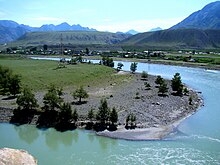

Diluvium is an archaic term applied during the 1800s to widespread surficial deposits of sediments that could not be explained by the historic action of rivers and seas. Diluvium was initially argued to have been deposited by the action of extraordinary floods of vast extent, specifically the Noachian Flood.
In 1822 and 1823, William Buckland published the term diluvium in his monograph Reliquiae Diluvianae and in G. A. Mantel’s monograph about the geology and paleontology of the county of Sussex. Buckland divided the surficial deposits overlying regional bedrock into diluvium and alluvium. Diluvium was defined as sediments, including boulder clays, laid down by geological processes that could no longer be observed. Buckland considered the Noachian Flood to be one of these geological processes no longer in existence. "Diluvium" eventually became widely used in Europe, and was retained even into the 20th century for glacial deposits, long after the Noachian Flood explanation was quietly abandoned. Buckland defined alluvium as surficial sediments laid down by processes currently active and observable, such as those associated with existing streams and coastal environments. In Germany, diluvium was also known as the Eiszeit or Glazialzeit and alluvium was known as the Postglazialzeit. Both were grouped together in the Quartär, or Quartäre Eiszeitalter, which is equivalent to the Quaternary Period.

In the late 20th century Russian geologist Alexei Rudoy proposed that the term "diluvium" be redefined to solely designate deposits created as a result of catastrophic outbursts of Pleistocene giant glacier-dammed lakes such as the Altai floods in the Altai Mountains. The largest of these lakes, Chuya and Kuray, had volumes of water in the hundreds of cubic kilometers, and their discharge in peak hydrograph flow rate exceeded the maximum rates of the well-known Pleistocene Lake Missoula floods in North America.
Deluvium, a slightly different spelling of diluvium, was sometimes used to designate diluvial sediments (diluvium). However, in 1888, Pavlov coined the term deluvium, with an e, to designate products of weathered and altered rocks carried by slopewash and deposited on slopes and plains. Currently, "deluvium" is used in Eastern and Central European countries like Lithuania and Poland to describe slopewash deposits.
See also
- Alluvium – Loose soil or sediment that is eroded and redeposited in a non-marine setting
- Colluvium – Loose, unconsolidated sediments deposited at the base of a hillslope
- Eluvium – End product of rock weathering
- Giant current ripples – Depositional forms in channeled scablands
- Illuvium – Material displaced across a soil profile
References
- Neuendorf, K.K.E., J.P. Mehl, Jr., and J.A. Jackson, eds. (2005) Glossary of Geology (5th ed.). Alexandria, Virginia, American Geological Institute. 779 pp. ISBN 0-922152-76-4
- ^ Kotlyakov, V. and Komarova, A., 2006. Elsevier's dictionary of geography: in English, Russian, French, Spanish and German. New York, Elsevier Scientific Publishing. 1072 pp. ISBN 9780444510426
- ^ Buckland, W., 1823. Reliquiae Diluvianae, or Observations on the Organic Remains Contained in Caves, Fissures, and Diluvial Gravel, and on Other Geological Phenomena, Attesting the Action of an Universal Deluge. 1st ed. John Murray, London, England. 303 pp.
- Mantell, G.A.,1822. The fossils of the South Downs, or illustrations of the geology of Sussex. London, England, L. Relfe. 327 pp. (p. 274)
- ^ Flint, R F., 1947. Glacial geology and the Pleistocene epoch. New York, John Wiley and Sons. 589 pp.
- Rudoy, A.N., 2002. Glacier-dammed lakes and geological work of glacial superfloods in the Late Pleistocene, Southern Siberia, Altai Mountains. Quaternary International, 87(1), pp.119-140.
- Rudoy, A.N. and Baker, V.R., 1993. Sedimentary effects of cataclysmic late Pleistocene glacial outburst flooding, Altay Mountains, Siberia. Sedimentary Geology, 85(1-4), pp.53-62.
- Lee, Keenan, 2004. The Altai Flood. Colorado School of Mines, Golden, Colorado. 12 pp.
- Wells, D.A., Cross, C.R., Nichols, W.R., Trowbridge, J., Kneeland, S. and Bliss, G., 1860. "The Annual of Scientific Discovery, Or, Year-book of Facts in Science and Art." Gould, Kendall, and Lincoln, New York. 430 pp.
- von Cotta, B., Noel, R.R., 1865. "Geology and History: A Popular Exposition of all that Is Known of the Earth and its Inhabitants in Pre-Historic Times." Trübner & Co., London.
- Pavlov, A.P., 1888. Geneticheskie tipy materikovykh obrazovanii lednikovoi i pozdnelednikovoi epokhi. Izvestiia Geologicheskogo komiteta, 7(7), pp. 78-96.
- ^ Miller, B.A. and Juilleret, J., 2020. The colluvium and alluvium problem: Historical review and current state of definitions. Earth-Science Reviews, 209, no. 103316
- Leopold, M. and Völkel, J., 2007. Colluvium: Definition, differentiation, and possible suitability for reconstructing Holocene climate data. Quaternary International, 162, pp.133-140.
- Baužienė, I., Świtoniak, M., Charzyński, P., 2008. Properties of deluvial soils in Poland and Lithuania and propositions for their classification.Žemės Ūkio Mokslai. 15(3), pp. 29–35.
| Glaciers | |||||||
|---|---|---|---|---|---|---|---|
| Types | |||||||
| Anatomy | |||||||
| Processes | |||||||
| Measurements | |||||||
| Volcanic relations | |||||||
| Landforms |
| ||||||
| Related | |||||||